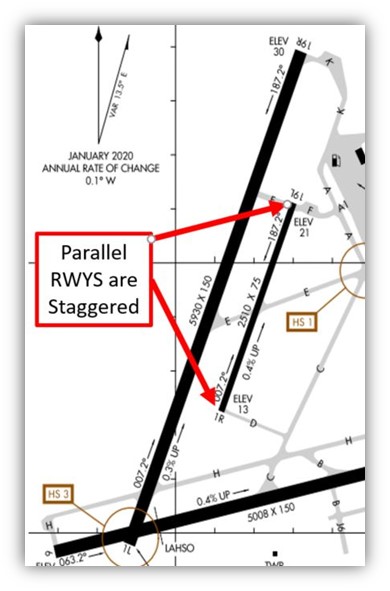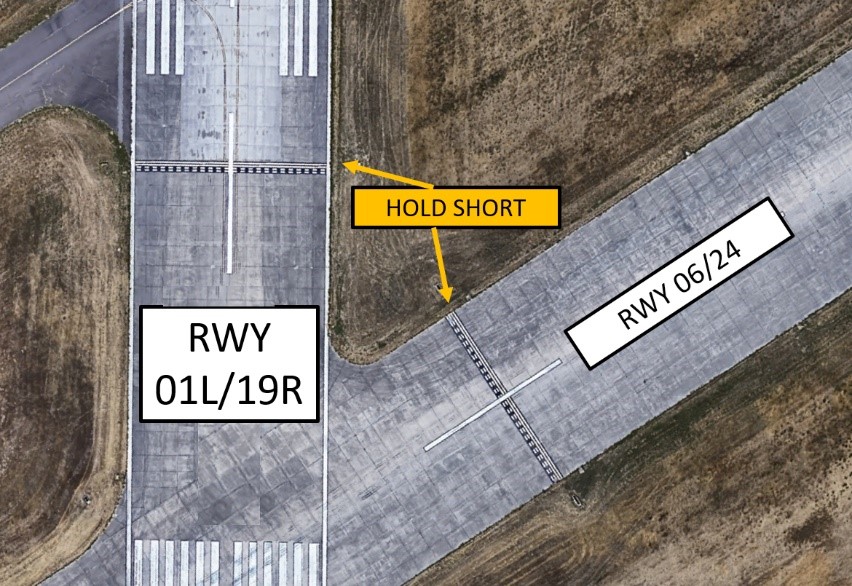Napa County Airport (APC)
Napa County Airport (APC) is a medium-sized, primarily corporate, and general aviation airport located between the cities of Vallejo and Napa in northern California. This location makes it an attractive destination for pilots visiting the famous Napa Valley wine country. Traffic consists of everything from experimental home-built aircraft all the way to large corporate jets. View a printable Pilot Handbook of the APC information found on this Web page.
Know Before You Go
- The runway configuration consists of two parallel RWYS with staggered thresholds – RWY 01L/19R and RWY 01R/19L. There is also a third intersecting RWY – RWY 06/24.
- RWY 06/24 intersects only RWY 1L/19R and does not intersect RWY 1R/19L.
- As with other airports with parallel runways and staggered thresholds, the possibility for wrong runway landings and departures exists at Napa.

- This happens primarily when the airport is landing parallel RWYs 19L and 19R.
- RWY 01R/19L is half the size of RWY 01L/19R.
- The thresholds are staggered significantly.
- RWY 01L/19R will be seen earlier on approach.
- Note that for operational reasons your assigned RWY can be changed.
- The surrounding terrain can be challenging for first-time transients to APC.
- Mountains to the N and NE do not allow straight-in approaches. A modified base leg entry is the normal VFR arrival.
- IFR aircraft can conduct an approach to either RWY 01L or RWY 06 and circle to RWY 19R.
- The airspace at APC is Class D with a 2,500 ft. MSL ceiling. (Refer to Sectional Chart)
Below find various APC-specific information and things to be aware of, as well as general information to inform your preflight planning. This will be reviewed quarterly and updated as needed. This information is to supplement the From the Flight Deck Videos that are produced by the FAA Runway Safety Group. Here you will also find information provided by the local air traffic controllers at the airport where you intend to fly. The information is subject to change. Not for navigation or legal* pre-flight action. Always refer to official pre-flight materials such as, but not limited to, NOTAMs, airport diagrams, VFR charts and airport construction notices for the latest airport-specific details.
APC Tower Operates from 0700L to 2000L Daily
Administrative Office Open 0800L to 1600L – Monday through Friday
Business Phone 707-255-1533
Hot Spots
HS 1: TWY A, TWY A2, TWY C, TWY E, and the ramp. Complex intersection and high density traffic area.
HS 2: RWY 24, TWY A. Aircraft and vehicles transiting to and from the hangers via TWY A sometimes cross RWY 24 at TWY A without clearance.
HS 3: RWY 24 and RWY 01L. Aircraft taxiing on RWY 24, do not cross RWY 01L without clearance. Aircraft taxiing on RWY 01L, do not cross RWY 24 without clearance.
Departure
- Verify proper heading prior to starting takeoff roll on all intersection departures.
- Wrong Surface Departure risk.
Landing - See Arrival Alert Notices.
- Wrong Surface Landing risk.
This happens primarily when the airport is landing RWYs 19L and 19R.

This has now changed to RWYs 19L/R due to Magnetic Variation.
- RWY 01L/19R is the dominant RWY and will be seen earlier on approach.
- Notice that RWY 01R/19L is half the size of RWY 01L/19R.
- The thresholds are staggered significantly.
- There are little to no white RWY markings in RWY 19L.
- Aircraft cleared to land on RWY 19L have landed on RWY 19R.
Surface Risk – Movement Area
- Hot Spot 1 is located at the intersection of TWYs A, A2, C, E and the ramp. Aircraft parked at the terminal or any of the transient parking areas must be aware that this intersection is high density and potentially confusing.
- Hot Spot 2 is located at the intersection of RWY 24 and TWY A. Aircraft and vehicles transiting to/from the facilities located on the SE corner of the field have crossed RWY 24 without clearance.
- Hot Spot 3 is found at the intersection of RWY 06/24 and RWY 01L/19R. During different traffic flows, the TWR may use these RWYs to taxi aircraft.
- In the illustration below, notice that the RWY Hold Short Markings are located prior to the RWY Intersection.

- Pilots who have been cleared to taxi on a RWY have failed to hold short of the intersecting RWY as instructed.
- You must always have clearance to cross any RWY – active or not.
Additional Cautions
- Due to airport proximity to wetlands birds on and in vicinity of the airport year around with highest concentration of activity of birds on the runways during rainy weather.
- There is an unlighted bridge 1 NM south of the airport – height 167’ AGL.
General
- When calling inbound to the airport be sure to include your intentions (full stop, pattern work, touch and go to the southwest, etc.) for ATC planning purposes.
- The area in the vicinity of the SGD VORTAC is heavily trafficked and is used often by IFR jet traffic inbound and outbound. If flying near this area always remain in communications with ATC for traffic advisories.
Traffic Patterns
- If your intentions change while flying in the traffic pattern, let ATC know as soon as practicable, preferably prior to making your turn onto final.
Ground
- Calling for taxi with the current ATIS code, direction of flight, and ramp exit point (A1-A4 if applicable) can mitigate unnecessary transmissions on the frequency and help ATC to be more efficient.
Take-off/Departure
- Our primary SID for IFR departures is the Merlot 3 Departure. Pilots do not often see MER3 in their FMS. Departing IFR aircraft will find the Merlot 3 in the physical FLIP booklet or other digital database.
Arrival/Landing
- Aircraft should be vigilant when requesting practice approaches to RWY 01L or RWY 06, as they are typically opposite the direction of landing traffic and may conflict with departing traffic.
- Remain vigilant for heavy bird activity located overhead the waste facility located at the approach end of RWY 24.
Special Traffic (Military / Commercial / Helicopter, etc.)
- Be cognizant of the Reach Helicopter ramp to the north of the airport and the California Highway Patrol (CHP) ramp to the south of the airport. Several helicopters arrive and depart from these areas daily.
Additional Information
- RWY 06/24 and RWY 01R/19L do not have over-runs.
- RWY 19R has an over-run on the approach end only.
- When TWR is closed, conduct Right Traffic Pattern on RWY 01R and RWY 19R.
